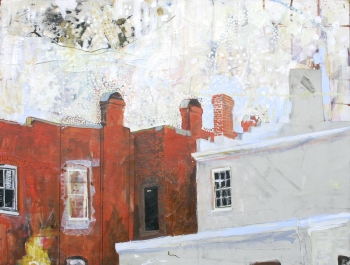The other day I came across the painting “Perpetual Revision” by artist Michael McDevitt on Zatista. As a writer, I can relate to the sentiment behind the title. It also makes me think about the notion of completion within the context of art in general.
When I watch my wife, who is a painter, or any of our artist friends work on a piece, I’m always intrigued by how they know the work is done. A lot of art mediums are cumulative – erasing marks or portions of the composition isn’t always an option, so covering is the only way to make revisions. As a result, there’s often a lot of “building” going on as layer upon layer is added to the piece.
Sometimes the revisions and additions become the piece itself, blurring together in a complimentary way. Other times, it’s what’s left blank that really matters. Still, what mystifies me is how artists decide that the last layer they completed is going to be the final one…
…and yet, sometimes the sense that one brush stroke more or less would have led to something other than completion is tangible to even the uninitiated. I don’t have the ability to tell my wife when one of her paintings is done, but I think I’m understanding more and more what it means to her to be finished.
It’s fascinating – the marriage of method and intuition – one of those magical non-verbal things that makes art such an awe-inspiring and valuable part of life.
_





Joe, thanks for making the statement:
“It’s fascinating – the marriage of method and intuition – one of those magical non-verbal things that makes art such an awe-inspiring and valuable part of life.”
It is very non-verbal, and makes it very difficult for a visual artist to explain why they do something to a piece. We are “feeling” our way through the process, working towards the moment of balance in the work. The creative process is a wonderful experience-quite addictive.
As one famous artist told me once, “Artist’s don’t finish paintings, they abandon them.” So true.
or they abandon them, or put them on the wall, only to finally see what the painting was asking for them to do! (I’ve done this many times)
Coming from the scrape and repaint school of working, I have a hard time trusting work that looks too “thin” and easy. Which is not to say that simplicity on the surface doesn’t mean weeks of repainting/subtracting….
But I also can appreciate the seemingly spontaneous gesture that comes with lots of history and a truly personal voice behind it.
Yup, it’s sometimes a mystery even to those who are in the midst of the process.
Nice post, and thanks for the mention.
For me it’s always a question of connection. Initially, the piece is only a sentiment, concept, or idea, existing entirely within the artist. Through an act as simple as sketching or jotting down a note the artist begins the process of realizing the work. Little by little, the artist brings the piece into the world, slowly shifting the balance from internal to external.
During this process there is an incredibly intimate connection between the artist and the work, but at some point the balance tips. The work acquires its own integrity and its own movement within the world. It is at that moment that the wise artist stops working. Any subsequent change is simply vandalism.
We spend our lives honing our technique and clarifying our vision, but it’s that moment of letting go which truly defines the Master.